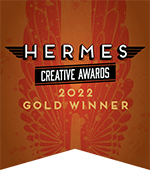
The good, the bad and the aesthetically atrocious: Graphic design trends we applaud and those we abhor
Graphic trends come and go, but great design is forever. As 2021 comes to an end and we all say good riddance to that abomination, we are reflecting on some of the less bad aspects of the past year. No, we’re not talking about the fact people may have finally learned how to properly wash their hands. Rather, we’re here to point out the positive design inclinations we’re seeing more brands become inclined towards.
Of course, with the good comes the bad. So, in addition to chatting about the winning design tactics we love, we shall also touch on two that we would prefer not to ring in the New Year with. Our intention is not to rid the world of bad design per say, but if we can help companies steer their creative in a more refined direction, we may sleep better at night.
Let’s start with the things we like…
A nice mix of the Natural & Manufactured
We’ve got to give it up to Mother Nature for all she’s created. The original and ultimate designer, nature brings so much beauty with it. Yet, it has often been overlooked in the modern landscape of design. While it may be easiest for natural food companies or beauty products to incorporate earthy elements, the glory of the outdoors should definitely not be relegated to these particular brands.
By incorporating natural elements, such as flowers, trees, herbs, etc., and aligning them with manufactured design principles, you can cultivate extremely sophisticated yet not overly contrived designs. Imagery and video that seamlessly incorporate these contrasting yet calming elements create a sense of serenity, trust and well-roundedness.
Think: a building with one side showcasing all its man-made magnificence, while trees and blooms bud from the other side. The messaging could be about a lifestyle complex incorporating the best of both worlds; an eco-conscious brand building brighter futures, blah blah, you get the drift.
Surrealism
Make Salvador Dali proud with your next foray into surrealist design. Surrealism attempts to expand the human conscious, so when you want to ignite your target audiences’ imaginations, it’s the perfect way to go. Expand beyond one-dimensional designs into dream-like visuals that juxtapose the everyday with the totally phenomenal.
Perfect for a fashion brand or for a business that appeals to high-value clients with high-value tastes, surrealism is not for the subtly minded. Rather, it’s a means of expression for bold brands. Use this medium to challenge the status quo and create conversation pieces that will inspire imaginative audiences to align with their messaging.
Modernized Retro
Think about this funky design trend as one that simultaneously celebrates Grease Lightning while pushing pause on the excessive hair gel and questionable fashion choices. Modernized retro design means big fonts, contrasting (usually bright) colours and simplified icons. The visual concepts are like Archie Comics with more than a splash of cosmopolitan refinement.
This trend is not for every brand and should likely be reserved for companies whose products align with a vibrant, fun flare. What we mean by that is perhaps insurance agencies should reconsider playing with oranges and aquamarines and leave this funky lens to foodies, fashionistas, car fanatics and beverage brands.
Now that we’ve explored the nicer side of design, let’s look at the not-so-attractive adversaries of the 2021-2022 ad design artist.
Tokenized diversity
While there is nothing more beautiful than the authentic representation of different cultures and colours, there is also nothing more offensive than brands using tokenized diversity to check boxes. When designing static or video advertisements, please do not use stock imagery or stock groups that include one member of every race, standing in an awkward, half-smiling, skin-crawling situation.
Diversity should look and feel authentic because it is. Whether you are representing health care products or you are a massive fashion conglomerate, you should be able to very easily represent all races because why the hell not? If you are looking through your brand assets and have to insert a person of colour every few frames to avoid backlash, you are doing diversity a huge disservice and you need to rethink the people sitting around your marketing (and maybe even boardroom) table.
Bees that are busy are cute, designs that are busy are difficult to look at
Some of the designs we celebrated above can certainly teeter on busy if they’re not done correctly. This is especially true for the modernized retro trend because of its love of bold colours. However, the way to protect yourself against design vomit is to ensure each element, within your piece, has a different volume:
Do not have a complex, super serif font floating amidst five contrasting colours. Do not incorporate a dichotomy of different images and layers alongside a hefty amount of text. Pick a lane and stick in that lane, minimizing the objects and design principles you’re using to create focal points. Otherwise, not only will your consumers’ eyes hurt, but they will be so overwhelmed by your design, they won’t take away any meaning from it.
Good design requires talent, organization and purpose.
If you want to affect people with your logo, advertisements and brand communications, it’s best to do a few things really well, rather than creating a cacophony of second-rate creative. Whether you are engaging in a redesign or you want to elevate your current messaging with better branding, reach out to our graphic design experts and let’s chat about how to achieve the good and bold, while avoiding the bad and ugly.


